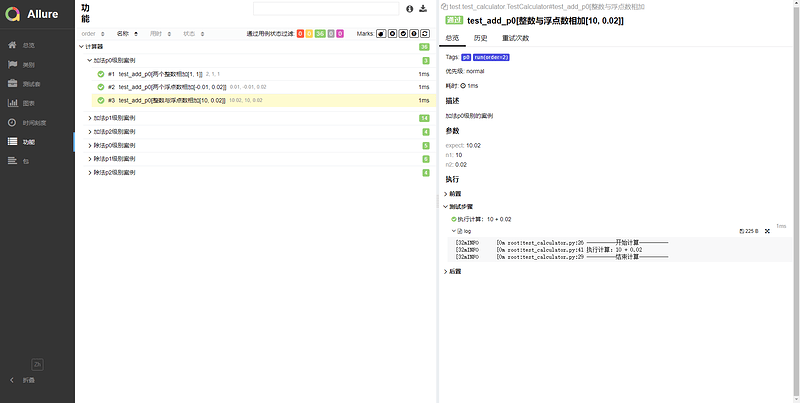from pythonCode.calculator import Calculator
import pytest
class TestCalculator:
def teardown_class(self):
print("结束测试")
def setup_method(self):
print("开始计算")
def teardown_method(self):
print("结束计算")
@pytest.mark.parametrize("first, second, excepted", [
pytest.param(1, 1, 2, marks=pytest.mark.p0),
pytest.param(-0.01, 0.02, 0.01, marks=pytest.mark.p0),
pytest.param(10, 0.02, 10.02, marks=pytest.mark.p0),
pytest.param(98.99, 99, 197.99, marks=pytest.mark.p1),
pytest.param(99, 98.99, 197.99, marks=pytest.mark.p1),
pytest.param(-98.99, -99, -197.99, marks=pytest.mark.p1),
pytest.param(-99, -98.99, -197.99, marks=pytest.mark.p1),
pytest.param(99.01, 0, "参数大小超出范围", marks=pytest.mark.p1),
], ids=["整数+整数", "负浮点数+正浮点数", "正整数+浮点数", "浮点数+整数", "整数+浮点数", "负浮点数+负整数", "负整数+负浮点数", "参数超出范围"])
def test_add(self, first, second, excepted):
calc = Calculator()
assert calc.add(first, second) == excepted
在此处键入或粘贴代码
练习1:
被测试代码为:
class Calculator:
def add(self, a, b):
if a > 99 or a < -99 or b > 99 or b < -99:
print("请输入范围为【-99, 99】的整数或浮点数")
return "参数大小超出范围"
return a + b
def div(self, a, b):
if a > 99 or a < -99 or b > 99 or b < -99:
print("请输入范围为【-99, 99】的整数或浮点数")
return "参数大小超出范围"
return a / b
用例设计为:
from pythoncode.calculator import Calculator
import pytest
class TestCalculator:
def setup_class(self):
print(‘创建实例化Calculator对象’)
self.calc = Calculator()
def setup(self):
print('开始计算')
def teardown(self):
print('结束计算')
def teardown_class(self):
print('测试结束')
#冒烟测试用例
@pytest.mark.parametrize('a,b,expected',[[1,1,2],[-0.01,0.02,0.01],[10,0.02,10.02]],ids=['整数相加','浮点数相加','整数和浮点数相加'])
@pytest.mark.p0
def test_add0(self,a,b,expected):
result = self.calc.add(a, b)
print(result)
assert result == expected
#有效边界值和无效边界值
@pytest.mark.parametrize('a,b,expected', [[98.99, 99, 197.99], [99, 98.99, 197.99], [-98.99,-99,-197.99],[-99,-98.99,-197.99],[99.01,0,'参数大小超出范围'],[-99.01,-1,'参数大小超出范围'],[2,99.01,'参数大小超出范围'],[1,-99.01,'参数大小超出范围']],
ids=['有效边界值1','有效边界值2','有效边界值3','有效边界值4','参数大小超出范围1','参数大小超出范围2','参数大小超出范围3','参数大小超出范围4'])
@pytest.mark.p1
def test_add1(self,a,b,expected):
result=self.calc.add(a,b)
print(result)
assert result==expected
# def test_add2(self):
# try:
# result=self.calc.add('中',9.3)
# except TypeError as e:
# print('异常信息:')
# print(e)
# def test_add2(self):
# with pytest.raises(TypeError) as e:
# result = self.calc.add('中', 9.3)
# print('异常信息:')
# print(e) #为什么需要对齐with才可以打印呢?---放在with里面是执行try里面的代码,print(e)应该是在捕获了之后才能打印
#异常情况的处理
@pytest.mark.parametrize('a,b,excepted',[['中',9.3,TypeError],['9.3','文',TypeError]],ids=['中文1','中文2'])
@pytest.mark.p2
def test_add2(self,a,b,excepted):
with pytest.raises(excepted) as e:
result = self.calc.add(a, b)
assert result==excepted-- coding: utf-8 --
@Time : 2022-04-11 10:45
@File : test_aa.py
import yaml
import pytest
from pythoncode.Calculator import Calculator
def get_data():
‘’‘获取yaml中的测试数据’’’
with open(’./data.yaml’,‘r’,encoding=‘utf-8’) as f:
datas = yaml.safe_load(f)
print(datas)
return datas
class TestCalculator():
def setup(self):
print(“开始计算”)
def teardown(self):
print(“结束计算”)
def setup_class(self):
self.call = Calculator()
def teardown_class(self):
print(“结束测试”)
@pytest.mark.P0
@pytest.mark.parametrize(‘a,b,expect’,get_data().get(“P0”).get(“data”),
ids=get_data().get(“P0”).get(“ids”))
def test_add00(self,a,b,expect):
res = self.call.add(a,b)
assert res == expect
@pytest.mark.P1
@pytest.mark.parametrize(‘a,b,expect’,get_data().get(“P1”).get(“data”),ids=get_data().get(“P1”).get(“ids”))
def test_add01(self,a,b,expect):
res = self.call.add(a,b)
assert res == expect
@pytest.mark.P2
@pytest.mark.parametrize(‘a,b,expect’,get_data().get(“P2”).get(“data”),ids=get_data().get(“P2”).get(“ids”))
def test_add02(self,a,b,expect):
with pytest.raises(eval(expect)) as e:
res = self.call.add(a,b)
assert res == expect
练习2:
from pythoncode.calculator import Calculator
import pytest
import yaml
def get_datas(level):
with open(’./datas.yml’,encoding=‘utf-8’) as f:
result=yaml.safe_load(f)
print(result)
add_datas=result.get(‘add’).get(level).get(‘datas’)
add_ids = result.get(‘add’).get(level).get(‘ids’)
print(f"{level}级别的datas为: {add_datas}")
print(f"{level}级别的ids为: {add_ids}")
return[add_datas,add_ids]
class TestCalculator:
add_p0_datas=get_datas(‘P0’)[0]
add_p0_ids=get_datas(‘P0’)[1]
print(add_p0_datas)
add_p1_datas = get_datas(‘P1’)[0]
add_p1_ids = get_datas(‘P1’)[1]
add_p2_datas = get_datas(‘P2’)[0]
add_p2_ids = get_datas(‘P2’)[1]
def setup_class(self):
print(‘创建实例化Calculator对象’)
self.calc = Calculator()
def setup(self):
print('开始计算')
def teardown(self):
print('结束计算')
def teardown_class(self):
print('测试结束')
#冒烟测试用例
@pytest.mark.parametrize('a,b,expected',add_p0_datas,ids=add_p0_ids)
@pytest.mark.p0
def test_add0(self,a,b,expected):
result = self.calc.add(a, b)
print(result)
assert result == expected
#有效边界值和无效边界值
@pytest.mark.parametrize('a,b,expected', add_p1_datas,
ids=add_p1_ids)
@pytest.mark.p1
def test_add1(self,a,b,expected):
result=self.calc.add(a,b)
print(result)
assert result==expected
#异常情况的处理
@pytest.mark.parametrize('a,b,excepted',add_p2_datas,ids=add_p2_ids)
@pytest.mark.p2
def test_add2(self,a,b,excepted):
with pytest.raises(eval(excepted)) as e:#eval让字符串变成一个表达式,完成运算,把它转成了一个类型
result = self.calc.add(a, b)
assert result==excepted思路:
使用参数化来实现计算器相加功能测试
*并没有完整写完,但思路和写法类似
1.先把case分类,下面分为几类:
P0(基础相加功能case),P1-1(有效值相加),P1-2(无效值相加:超出数值范围)
2.上面每个分类对应一个test case方法,如下:
test_Ca_add_P0
test_Ca_add_P1_1
test_Ca_add_P1_2
3.每个方法里面验证方式基本一致
通过调用原calculator add方法进行测试
4.add方法需要传参两个加数,另外我们还要传期望结果,所以总共传三个参数x,y,except
5.每个测试方法添加修饰器来进行传参@pytest.mark.parametrize
6.编写yaml文件,把测试数据写入
7.编写get_data方法来获取对应参数(test_func.py),注意这里我把对应等级priority作为参数传入这个方法
test_cal.py
import allure
import pytest
import yaml
from code.caculator import Calculator
from test import test_func
@allure.feature("计算器功能")
class TestCalculator:
def setup_class(self):
self.cal = Calculator()
def setup(self):
print("开始计算")
def teardown(self):
print("结束计算")
# @pytest.skip
@pytest.mark.P0
# @pytest.mark.run(order=3)
@allure.story("相加基本用例")
@pytest.mark.parametrize("x,y,expected",test_func.get_data("P0")[0],
ids=test_func.get_data("P0")[1])
def test_Ca_add_P0(self,x,y,expected):
result = self.cal.add(x,y)
assert result == expected
@pytest.mark.P1
# @pytest.mark.run(order = 1)
@allure.story("有效值相加")
@pytest.mark.parametrize("x,y,expected",test_func.get_data("P1-1")[0],
ids=test_func.get_data("P1-1")[1])
def test_Ca_add_P1_1(self,x,y,expected):
result = self.cal.add(x,y)
assert result == expected
@pytest.mark.P1
# @pytest.mark.run(order=2)
@allure.story("无效边界值相加")
@pytest.mark.parametrize("x,y,expected",test_func.get_data("P1-2")[0],
ids=test_func.get_data("P1-2")[1])
def test_Ca_add_P1_2(self,x,y,expected):
try:
result = self.cal.add(x,y)
assert result == expected
except TypeError as e:
print(f"输入有问题,输入值为{x,y},抛出异常:{e}")
test_data.yml
add:
P0:
Ca_add_001:
- 1
- 1
- 2
Ca_add_002:
- -0.01
- 0.02
- 0.01
test_func.py
def get_data(priority="P0"):
data = yaml.safe_load(open("../data/test_data.yml",encoding = 'utf-8'))
data = data.get("add")
result = []
# print(type(data))
# print(f"data is {data}")
# print(type(data["P0"]),data["P0"])
for item in data[priority].values():
result.append(item)
print(result)
return [result,data[priority].keys()]

